
In forests, there is a huge number of various edible mushrooms species. In the summer, they are boiled, fried, and also prepared for the winter dried, pickled, and frozen. This is a very tasty and nutritious product that helps to greatly diversify the diet. Today we want to tell you about the best mushrooms for pickling and storing for winter.
Table of Contents
best mushrooms for pickling
Let’s discuss one by one the best mushrooms for pickling with features, hunting, storing, pros and cons.
1. White mushroom
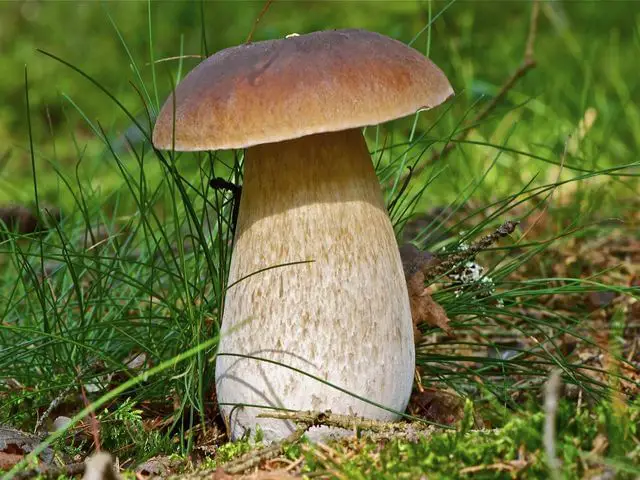
At the top of our ranking of the best mushrooms intended for winter harvesting, this breed was quite predictably. It is distinguished by marble-white flesh, it does not darken on the cut, and also retains its color during any heat treatment. As is commonly believed, this is the so-called noble mushroom, which has unique taste and nutritional properties. Their high nutritional value allows them to be used in a variety of dishes. White fungus is widely distributed throughout the country. Depending on the climatic zone, season and growing conditions, the general ecological situation, the appearance can be very different, but the general signs will still be there. The cap has a convex shape in young mushrooms, in mature specimens it becomes flat. At the edges it is lighter than the center. The surface is usually smooth and slightly velvety, becomes slippery in wet weather. The color of the pulp also depends on natural conditions – it varies from white to dark brown. The cap diameter ranges from 5 to 25 cm, sometimes there are especially large specimens – up to 50 cm.
The leg is usually very massive, has the shape of a barrel, expands towards the bottom, it is lighter than the cap. The pulp is dense, milky-white in color, and the thickness of the leg can be 5-7 cm. It is worth noting that most of the leg is located underground. When cut, the mushroom will not darken, its flesh has a pleasant aroma with pronounced nutty notes. The smell only intensifies as the mushrooms dry. There is absolutely such a mushroom – the exceptions are Antarctica and Australia. Feels best in coniferous and coniferous-deciduous forests, and appears from June to September.
Pros:
- During cooking, it practically does not lose in volume and mass;
- Suitable for cooking any dishes;
- Excellent aroma and dense structure;
- Well visible against the backdrop of foliage.
Cons:
- A significant part of the leg is underground – you need to cut the mushroom very carefully.
Check out Mushrooms That Grow In Autumn.
2. Forest champignon mushroom
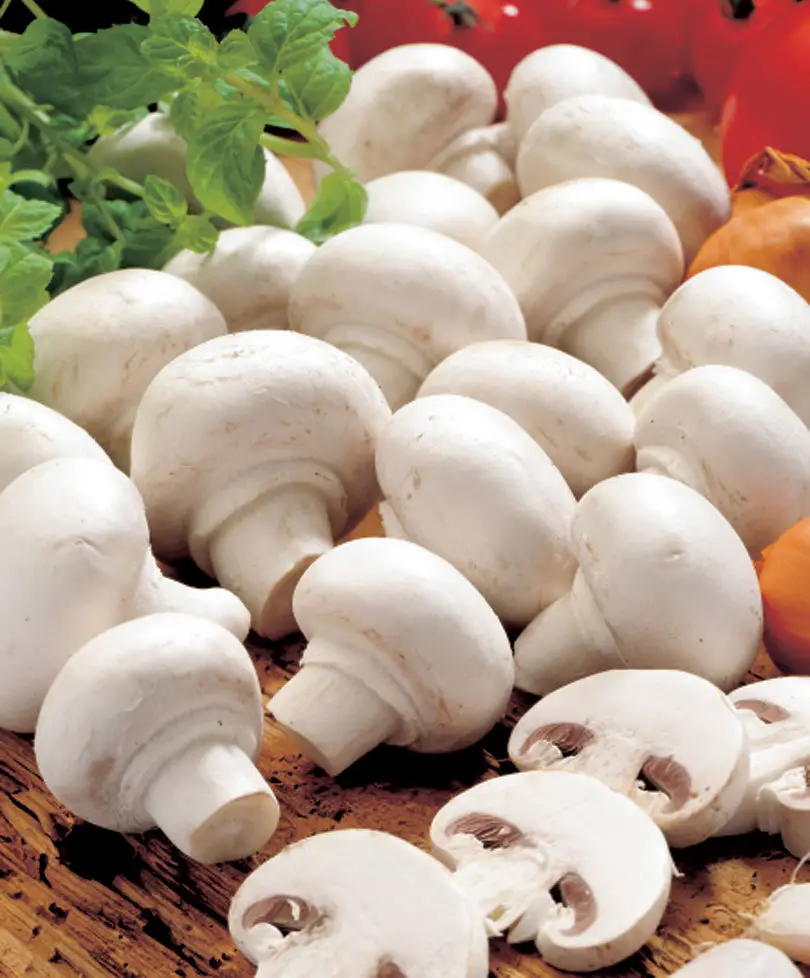
A mushroom that is very popular with housewives, as it is distinguished by its good taste, can be used to prepare a variety of mushroom dishes and is very common in forests. If desired, champignons can be grown independently. The cap diameter ranges from 5 to 10 cm, there are individual specimens with a size of 15 cm or even more. Initially, the shape resembles a chicken egg, but as the individual grows older, it changes a little and becomes like a saucer. The upper part of the cap is covered with rather large scales, which are usually grayish-brown in color. If you push through the pulp of the cap, then the area will first turn red, and then turn brown. The diameter of the leg is approximately 1.5 cm, it is 10-12 in height, occasionally up to 15 cm. Outside, the leg is scaly, with noticeable fibrous, and has a white or grayish color. It is usually made in the form of a cylinder, often curved.
The pulp of the mushroom is somewhat brittle and has a characteristic mushroom aroma and a pleasant taste with a sweetish aftertaste. Champignons are widely distributed in the temperate climate zone of the European part of the country. In most cases, they grow in spruce forests, entering into symbiosis with the roots of coniferous trees. Soils rich in manure or hummus are very fond of such mushrooms, so they are often found on pastures, in the immediate vicinity of barnyards and stables, and can even grow on anthills. The first harvest of mushrooms is harvested in August, the collection continues until the beginning of September.
Pros:
- Does not require pre-soaking;
- The film is removed from the hat with ease;
- Can be dried, salted and pickled – suitable for any kind of winter harvesting.
Cons:
- During drying, it greatly decreases in size;
- Old mushrooms are often quite tough.
3. Saffron Milkcap (Orange Milkcap)
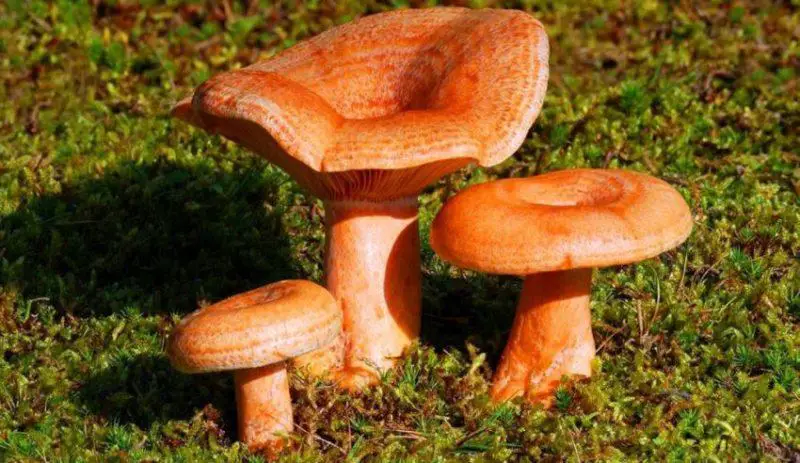
In third place in our ranking of the best mushrooms for winter harvesting was a very valuable variety, characterized by an original and unique taste, in addition, it has a number of useful qualities. This is a very beautiful agaric, like the chanterelle, which has a juicy orange color. The fruit body is quite dense, the dimensions are insignificant. The diameter of the cap in large specimens can reach 20 cm. Young mushrooms have a flat cap, in which the fields are tucked inward. As it grows, it gradually straightens and forms a smooth edge, and on the outside, it will take the form of a funnel. The surface is perfectly smooth and has a slimy coating that is slightly sticky. The color may vary slightly, but as a rule, it is still a shade of orange. The plates under the cap are located tightly.
The height of the leg usually does not exceed 7 cm, its diameter is 1.5-2 cm. In shape, it is similar to a cylinder truncated to the bottom. If the leg is cut, it becomes clear that it is hollow, even with minor deformations it acquires a greenish tint. Such mushrooms grow in the central and northern regions, are found in large numbers, and are found in the southern mountainous regions. For the fastest growth, a temperature regime in the range of 15-27 degrees is desirable. Mushrooms do not like too shaded areas and waterlogged soil, they feel comfortable in a sandy loamy soil. Mushrooms are harvested from July to October, the fruiting body is formed in the warm season. This is one of the latest mushrooms, which are harvested until hard frosts. Ginger belongs to the elite mushrooms, and can be consumed boiled and fried.
Pros:
- Found in forests from July to late autumn;
- It has many useful compounds and vitamins;
- Great for winter preparations.
Cons:
- It can be easily confused with other types of mushrooms, and not always edible.
You may want to know Mushrooms That Grow On Poplar Trees .
4. chanterelle mushroom
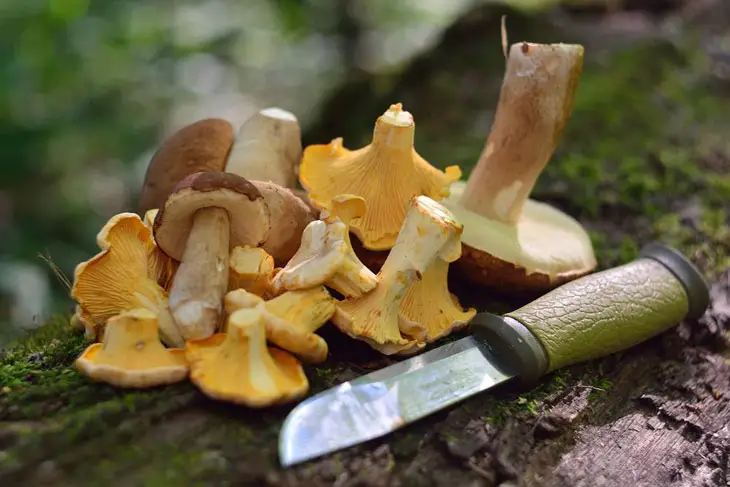
It is difficult to confuse it with other mushrooms. The hat has a very bright color, reminiscent of egg yolk, there are also faded specimens – they are completely white. The shape of the cap is rounded, and there is a slight bulge, over time it becomes flat at first, and then completely turns into a funnel, the edges of which are turned down. The diameter of the cap can reach 12 cm. It is not so easy to separate the skin. The pulp has a slightly sour taste, and the smell is characteristic, with fruity and herbal notes. The leg is completely fused with the cap, the flesh does not differ in color, and there is slight fibrousness.
Most often, chanterelles are found in European mixed forests, widespread in regions where there is a temperate climate. Usually adjacent to such tree species as beech, pine, oak, and spruce. Mushrooms grow on rotting forest floors, love moss, and are places with moderate humidity. After heavy thunderstorms, they break through in significant groups. The harvest season for chanterelles is August-October. Chanterelle can be eaten in absolutely any form – boiled or fried, pickled or salted. After cooking, the sour taste disappears, and the mushrooms become quite tender, a little sweetish.
Pros:
- It grows in large groups – you can immediately pick up a lot of mushrooms;
- Prepared in a variety of ways;
- Delicate flesh with a slight, barely noticeable sourness.
Cons:
- It is easy for an inexperienced mushroom picker to confuse with a false chanterelle;
- It is problematic to separate the skin from the cap.
5. slippery jack suillus luteus
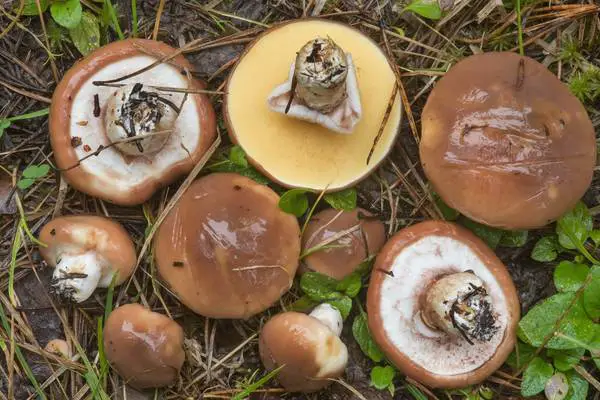
It belongs to the third taste category, but with the right heat treatment and cooking method, it fully reveals its qualities. The mushroom is very compact in size, has a rather thick stem and a convex cap, usually light brown in color. The hat itself in adults can grow up to 10 cm in diameter. Young butterflies have a hat in the form of a hemisphere, it becomes convex in the future. Its edges are first bent, then straightened. The color can be light brown with the addition of a yellowish tint, the entire surface of the cap is covered with small scales. With an increased level of humidity, it becomes a little sticky and oily – hence the name of the fungus. The leg has the shape of an almost regular cylinder, usually yellowish in color, there is no skirt on it. The pulp of the mushroom is quite hard, fibrous, may have a whitish tint, but on the cut it begins to darken quickly to blue. Butterflies have a medium pronounced aroma of needles, the taste is rather weak, in some cases it is completely absent.
It is found throughout the country, most of all prefers sandy soils, grows in groups or alone, in wet and warm weather, mushrooms grow quite large. It often appears on peat soils, but there is an important condition here – it is necessary that pine trees grow nearby. It is believed that butternuts are most suitable for pickling, but they should not be packed too tightly in the container, since such mushrooms can stick together with each other. In general, processing these mushrooms is very simple – you don’t have to boil them additionally before cooking. You can also dry butterflies: only small hats are suitable for this, which must first be carefully sorted out and the worms removed.
Pros:
- For the most part, they grow in groups, which greatly facilitates their collection;
- You can cook in different ways;
- Pleasant taste and delicate coniferous aroma;
- Found everywhere.
Cons:
- It is not worth stuffing too much when marinating – the mushrooms simply stick together with each other.
6. Orange Birch Bolete mushroom
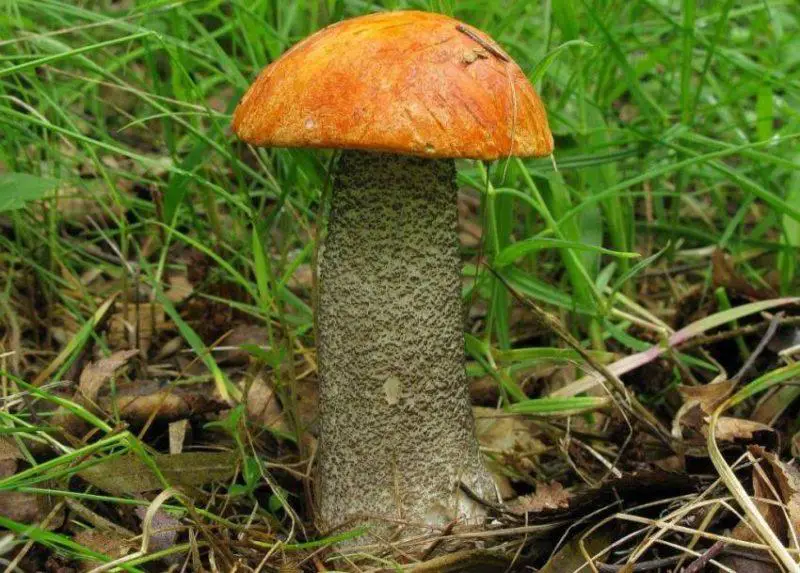
Belongs to edible mushrooms of the second category. This means that the product does not need special preparation such as soaking or evaporating, however, in terms of its taste characteristics and nutritional value, it is inferior to mushrooms belonging to the first category. Young aspen mushrooms have a ball-shaped hat, which is located on a very thick stem. As the mushroom matures, it begins to open, and its edges diverge. A fully ripened boletus has a dome-shaped hat, which is bright red or brick in color. It is velvety to the touch, at the edges the skin can be slightly separated from the pulp. It must be remembered that the shade of the cap directly depends on where exactly the mushroom grew. If there were poplars nearby, then it becomes grayish, next to aspens it acquires a pronounced red color when the boletus grows in a mixed forest, he has an orange hat. The mushroom has a thick and strong leg in adults it reaches a diameter of 5 cm. At first, it is white, then it turns gray, and later it acquires a brown tint.
The pulp of the fungus is hard and very dense, with growth and subsequent aging it becomes flabby and softened. The leg has a fibrous structure. When cut, it is first white, then darkens to black. Raw mushroom does not have a characteristic taste and smell. Most often it grows in an aspen forest, but it can also be found in a mixed one; such a mushroom cannot be found only in a pine forest. The first aspen mushrooms appear at the very beginning of summer and grow until July. The second wave of fungi begins closer to mid-August, the third – in the autumn months, and at this time they are most observed. Aspen mushrooms grow, as a rule, singly, small clusters are rare. The mushroom is edible in all variations – it can be dried, pickled or salted, or frozen.
Pros:
- Widespread;
- In suitable conditions, it grows in large numbers;
- Beautiful appearance;
- Suitable for all types of cooking and harvesting.
Cons:
- During cooking, it may change its original color.
Must check guide on Edible Mushrooms That Grow On Trees.
7. birch bolete Mushroom (Leccinum scabrum)
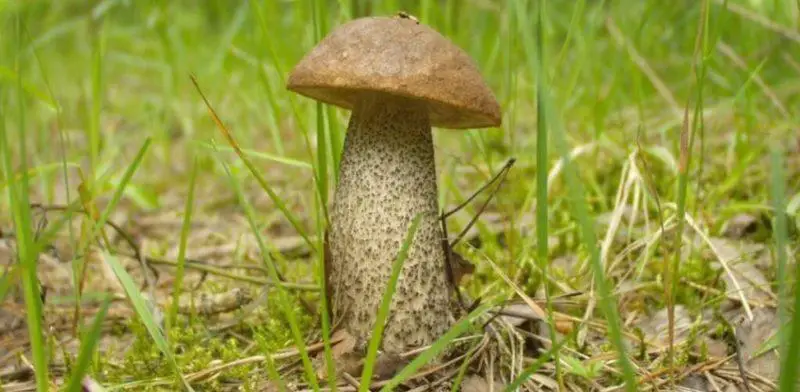
Edible cap mushroom, which has a wide habitat. In terms of taste and overall dimensions, it resembles a white mushroom, but there are significant differences. In particular, the birch boletus turns black during cooking, while the white one does not change its noble color. The boletus grows very, very quickly – under favorable temperature and humidity conditions, it can stretch up to 4 cm per day. On about the fifth day after germination, the fungus fully matures and begins to age just as quickly. For this reason, boletus should not be stored unprocessed, even in the refrigerator. After harvesting, they are cleaned as quickly as possible, then boiled or frozen. The mushroom cap is characterized by a regular hemispherical shape. As the boletus matures, it becomes flatter, begins to resemble a pillow, but the bulge is still preserved. The surface of the cap is smooth, with high humidity it becomes a little slimy, which resembles butter.
The pulp of the mushroom is quite dense, soft, may turn a little pink in the cut area, and has a pleasant smell. The lower part of the cap is tubular, has a white or grayish color. During heat treatment, it breaks into fibers, which can greatly spoil the appearance of the dish, so it is usually removed before cooking, and besides, it is easily separated. With age, the fruiting body becomes wormy, so the fungus should definitely be checked for the presence of a worm in it. Mushrooms grow near birches and some other deciduous trees; they can be found in spruce forests and mixed forests. Often they are found in swampy areas, on roadsides. The largest boletus grows in Siberian forests. The first mushroom harvest can be harvested at the very beginning of June, but it grows most actively from late July to mid-September.
Pros:
- Can be cooked in a variety of ways, including pickling, salting, and freezing for the winter;
- Contain a large amount of vitamins;
- Low-calorie products;
- The pulp of the mushroom has anti-inflammatory properties.
Cons:
- Be sure to separate the tubular layer from the cap.
8. Suillellus luridus
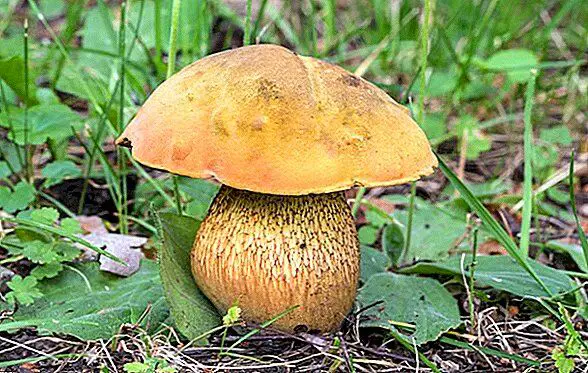
It belongs to the mushroom genus and contains certain poisons, therefore it is considered to be conditionally edible, however, in some reference books, the mushroom is designated as edible. It has large dimensions. In particular, the stem can be up to 6 cm in diameter, the height of the mushroom reaches 12 cm, and the cap diameter is 20 cm; larger specimens were also found. The hat has an olive or brownish color, often there is a slightly reddish tint, it has the shape of a hemisphere. At the cut site, the leg first turns blue, and after a while, it acquires a dark brown tone, therefore, in the common people, this mushroom was simply called a bruise. From the moment of germination, the stem has the shape of a barrel, then it gradually stretches, becomes cylindrical, its color is yellowish, and there are red streaks, which are usually quite a lot in the base area. A fresh cut is also initially reddish. Dubovik grows best in symbiosis with the roots of birches, oaks, and beeches. Prefers calcareous soils in bright areas where direct sunlight can easily pass.
As a rule, it is collected towards the end of summer, but sometimes it comes across at the end of spring. The mushroom is considered edible only after thorough and prolonged heat treatment. It is allowed to dry. After boiling, the water must be completely drained, as it contains poisons washed out of the body of the fungus. Dubovik can be pickled for the winter, and fried with onions or potatoes. It is served with sour cream and various sauces. In terms of taste, it is practically indistinguishable from white fungus. A raw or undercooked mushroom, if it enters the gastrointestinal tract, can cause serious upset, the products are especially dangerous in combination with strong drinks.
Pros:
- Found in all regions;
- Possesses excellent taste;
- Quite a large mushroom;
- Grows in spring and summer;
- He likes sunny places, so it is easy to find him.
Cons:
- Requires a very long heat treatment;
- Contains certain poisons, leading to an upset of the gastrointestinal tract;
- Not compatible with hard liquor.
9. armillaria mellea edible
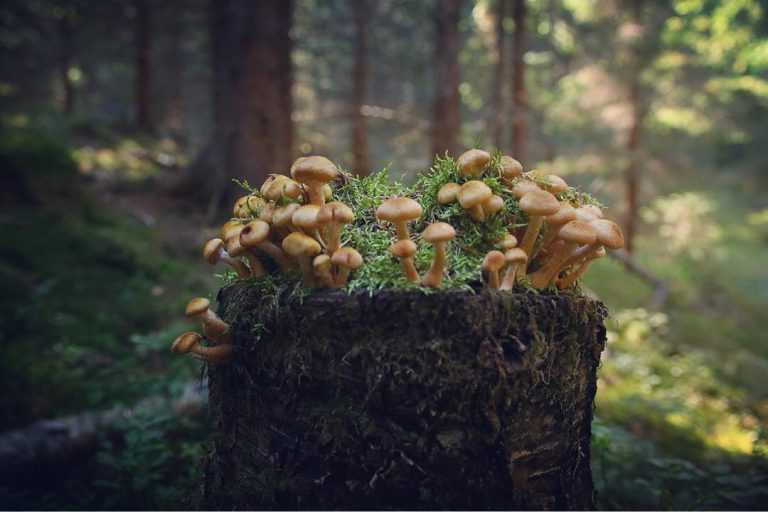
Belongs to the group of conditionally edible mushrooms, therefore, before eating, products must undergo additional processing without fail. Characterized by excellent taste properties. It usually grows on stumps or in the immediate vicinity of them. It can be found from August to November. It does not need complex processing – honey mushrooms just need to be washed and sent to a pot or pan. The diameter of the mushroom cap is in the range from 3 to 15 cm. It is quite thin, in a young mushroom it is spherical, in an older one it is prostrate, in the central part there is a small tubercle. The color is usually ocher or brown-yellow, small brown scales can be observed. The edges of the cap are initially wrapped inward, as the fungus matures, they straighten out. Leg length can reach 18 cm, they are no more than 2.5 cm in diameter. It is rather dense, round or cylindrical, fibrous. The pulp of the mushroom is also very dense, thin-fleshed, has a white color, retains its color at the fracture site, has a pleasant aroma and taste.
Experienced mushroom pickers recommend eating only hats, legs can only be eaten by young mushrooms, as they become very tough in old ones. Autumn mushroom can be used for any type of cooking, most often it is salted or pickled, which allows you to fully reveal the taste and keep it edible for a long time. The habitat is wide – the mushroom is found both in the tropics and in areas adjacent to the Far North, in absolutely all time zones. Quite large colonies of mushrooms grow near birch stumps, as well as other species of deciduous trees. If the forest is about 30 years old, then it will definitely be possible to find honey mushrooms there. In particularly fruitful years, it can grow on leafy litter and even in grass.
Pros:
- Quite a tasty mushroom;
- It can be processed in a variety of ways – boil, fry, dry, pickle, pickle, and so on;
- Before cooking, you just need to wash;
- Found almost everywhere.
Cons:
- An undercooked mushroom can cause serious poisoning;
- Before cooking, you need to carefully sort out and remove the legs of old mushrooms.
Details about Armillaria Mellea Edible Mushroom.
10. Edible raincoat Mushroom
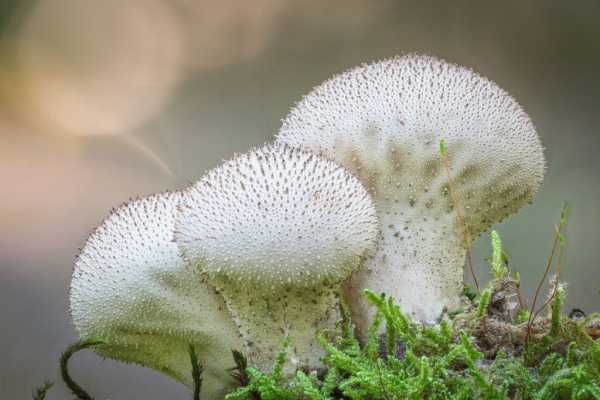
The fruit body of the plant is spherical, more reminiscent of the shape of a ball, however, there are specimens in the form of a mace or pear. The upper part is no more than 5 cm high; mushrooms up to 8-12 cm high can also be found, but such individuals are extremely rare. Young mushrooms are pearly white in color. The skin is covered with small growths in the form of thorns. They separate easily when touched. With age, the skin of the fungus acquires a brown tint. The flesh is white, and quite elastic, as it matures, it first becomes greenish, and later olive-brown. The raincoat is found absolutely everywhere except for Antarctica. The fungus is not sensitive to soil acidity, which allows it to grow in various types of forests, meadows, and fields. Often it can be found in the area of or stables since it grows most actively on soils well-fertilized with manure. Grows fastest after rain.
Many mushroom pickers ignore the raincoat, considering it inedible, but the pulp of the mushroom is characterized by a pleasant and delicate taste. It is advisable to eat only young mushrooms. As soon as the flesh acquires a green tint, it becomes tasteless. Raincoat fully reveals its taste in soup, but it can also be fried. It is prepared immediately after harvest because the pulp becomes flabby and tasteless over the next two to three hours. It cannot be dried or pickled, but it can be frozen for future use. Often the mushroom is used for medical purposes. First of all, it is an excellent hemostatic agent. The dried mushroom powder can be mixed with honey – the result is an excellent remedy for combating sore throats and tonsillitis. The pulp of the fungus allows you to bind and remove heavy metals from the human body.
Pros:
- Very widespread;
- Tender and pleasant to taste pulp;
- You can cook in different ways.
Cons:
- It is necessary to cook immediately after collection;
- Many mushroom pickers neglect the raincoat, considering it tasteless.
Conclusion
So we have finished considering the most widely known best mushrooms for picking and mushroom types of mushrooms suitable for storing for winter. The only thing I would like to wish for is caution, since even experienced mushroom pickers sometimes make mistakes, and they come across inedible and poisonous mushrooms. If you have some experience in harvesting mushrooms, then in the comments of this article you can share recipes or little tricks with other readers.